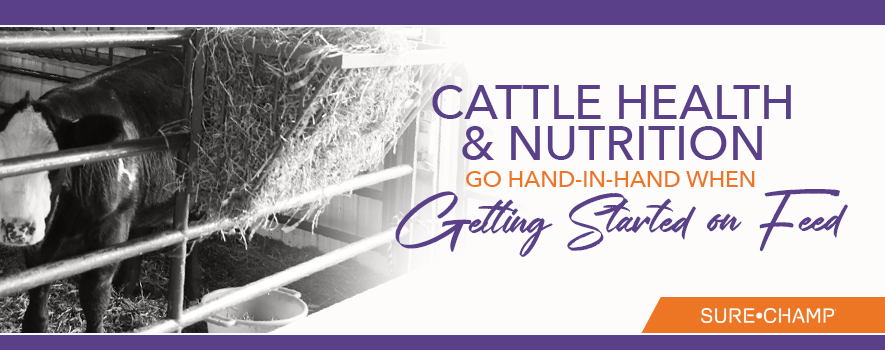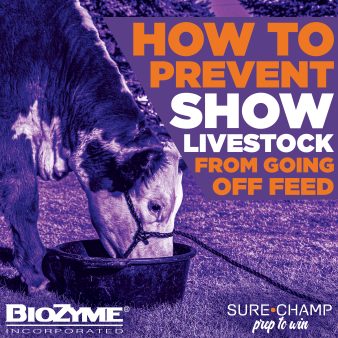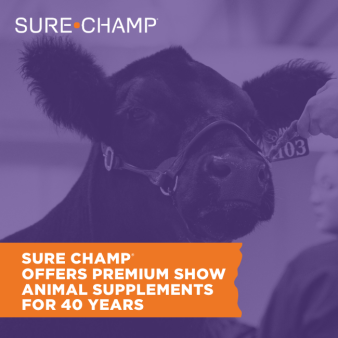
The excitement of buying your new show calf projects can be overwhelming. You’ve likely driven lots of miles to find just the “right ones” that will match your desired end-point, and now it’s time to bring them home and get them on feed. However, getting your show calves on a feeding program isn’t as simple as weighing out grain and throwing a few flakes of hay their way. With the help of Blaine Rodgers, Show Livestock Business Development & Field Support for BioZyme® Inc., we have complied seven steps for getting your show cattle started on feed.
- Make sure their health is in order. When it is time to load up your new calf and bring it home, have a conversation with the breeder or the seller of the calf to make sure it is current on all vaccinations and worming. Giving an additional wormer when you get all your calves home – especially if they are coming from multiple farms will not hurt anything and will get them on the same regimen. You have the options of an injectable, oral or pour-on wormer. Choose one, treat all the calves the same and rest assured that they have been wormed. Another treatment you might consider giving your calves as soon as you get them home is an internasal vaccine that will give an immediate response to any respiratory sickness caused by stress.
Additionally, Vita Charge® Gel is always a great tool to help your calf transition with ease. The quick-response gel supports digestive health and promotes feed and water intake during times of stress and recovery.
- Introduce calves to their water source. Since water is the most vital nutrient to all livestock, it is important your calf has a constant, fresh, clean water source. As soon as you get your calf unloaded, be sure it knows where the water tank is, so it doesn’t go without and become dehydrated. </p>
- Make the feed transition gradually. One of the things you want to ask the seller is what kind of diet the calf was on. If you don’t have that particular brand or type of feed, try to get a bag or small amount to bring home with you so you can make the transition to your preferred feed as smooth as possible. Start with the feed the calf has been eating and gradually mix in your new feed, slowly replacing the old feed with your feed over a transition period.
Also, don’t give full feedings immediately. If the calf was on 12 pounds of grain, cut back and slowly increase the feed until the appetite is back to 100-percent and the calf is ready for full feed again. It is best to feed it in a bunk instead of a feed pan when first getting it to eat so it learns to eat from a bunk. The calf will also waste less feed due to spills or stepping in it.
- Provide good-quality hay. Keep free-choice hay available to your calf to keep fiber content up and its digestive tract healthy. Any animal that is on a grain-based ration should be fed grass hay, grass-hay blend or grain or forage hay. Don’t compromise the quality of hay, but don’t focus on feeding a forage high in protein like alfalfa, since the calves are getting their protein from their grain ration.
In addition to aiding the digestive tract, free-choice hay will also help your calf alleviate stress. Eating hay gives it something to do during the day, when it otherwise might get bored.
- Provide supplements. One thing that cattle exhibitors often overlook is the need to provide supplements to their show animals. Salt is good to have out for them. It is also good to include Vita Charge Stress Tubs that support digestive health and promote feed and water intake during times of stress and recovery. All Vita Charge Products contain MOS and Amaferm®, is a prebiotic designed to enhance digestibility by amplifying the nutrient supply for maximum performance. It is research-proven to increase intake, digestion and absorption.
MOS traps bad bacteria limiting their ability to do harm. </p> - Watch them eat. Rodgers said a person can tell a lot about the health and nutrition of his or her show animal by spending some extra time watching the calves eat.
“One thing that is key to focus on: don’t throw their feed in the bunk and leave. Watch them eat. It will tell you a lot about their health. It will tell you how good their appetite is. Watch how fast they eat; see how much feed they leave behind. All those things will tell you about their feeding program. Observation is one of the most critical things you can do during the feeding program.”
If you see your calf cleans up its feed in a hurry, maybe it is time to increase feed. If the calf doesn’t eat all its feed or takes a long time to eat, perhaps you need to back off on its feed.
- Keep a schedule & keep them together. It’s best to keep your calf on the same feeding schedule each day, and typically about 12 hours apart. This allows for the microbial impact of the digestive tract to work properly, and it establishes behavioral patterns for your cattle. Feeding time is a good time to tell if calves are getting sick because if they don’t come up to eat, that is an indication they are not feeling well.
Another piece of advice for getting your calves started on feed when you first get them home is to feed a couple calves together if they are on similar diets. The competition is good to get them to the bunk to eat. However, as they get older and their diets change, you will likely want to feed them separately.

